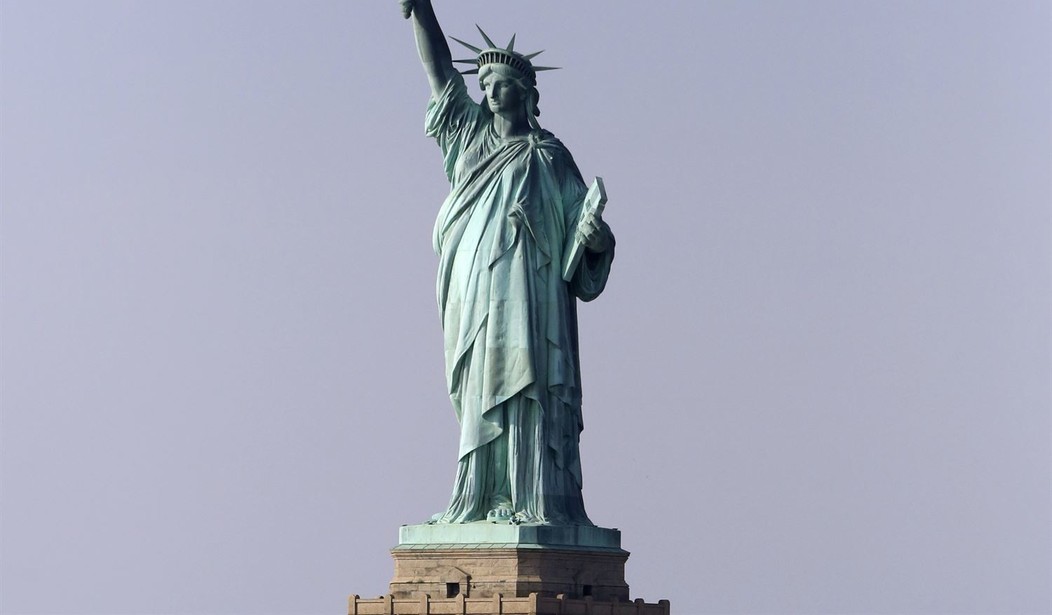
Misunderstanding Lady Liberty: Why We’re Free in America
(Townhall.com) – For diversity enthusiasts, the crowd on and around the Statue of Liberty on a recent Sunday looked like the United Nations General Assembly out for a stroll sans diplomatic garb. Most, if not all races, seen and many languages overheard, women and girls in outfits from chadors to yoga pants and crop tops, men and boys in baggy shorts and T-shirts advertising everything from antique rock n’roll groups to billion-dollar sports franchises. More than a few males and females mistook flip-flops for footwear. Tattoos everywhere.
Attire notwithstanding, there was something heartening in feeling, apparently, along with so many others, the grand statue’s magnetism. The great American flag over the walkway leading from the ferry landing toward that iconic structure waved gently in affirmation. E Pluribus unum a reality.
Yet something was amiss. The new museum on Bedloe’s tiny island (now Liberty Island) neatly summarized how the Statute of Liberty came to be but not entirely why it was possible only in America. Not entirely why the multifarious visitors—especially all the U.S. citizens among them, native- and foreign-born alike—were individuals free and equal, possessing unalienable rights.
There are films and exhibits, some interactive enough to enable tourists to post selfies and visually include themselves (temporarily) in a large wall screen mosaic of the American immigrant epic. From French poet and anti-slavery activist Edouard de Laboulaye’s 1865 proposal for a gigantic monument to commemorate Franco-American ties and, with the Union victory in the Civil War, abolition of slavery in the United States, to the 1886 dedication of sculptor Frederic Auguste Bartholdi’s colossus of creative engineering, Liberty Enlightening the World, the exhibition educates painlessly.
But it doesn’t quite explain. Why was it that only in America, in the 5,000-plus years of recorded human history, would the idea of a republic—through sometimes painful, bloody extensions epitomized by the War Between the States—come to be? A republic in which “all Men are created equal, and endowed by their Creator with certain unalienable Rights, and among these are Life, Liberty and the Pursuit of Happiness.”
The modernist museum covers 26,000 square feet and cost more than $70 million. It was funded by corporate-entertainment luminaries, including Diane von Furstenberg, Michael Bloomberg, Jeff Bezos, Coca-Cola, NBCUniversal, the Tisch family, Mellody Hobson, and George Lucas, and opened in 2019.
It properly focuses on America as a nation of immigrants, all kinds of immigrants—Ellis Island lies nearby. Displays nod to contemporary sensibilities about diversity and inclusion. But, with 14 percent of the United States’ 330-million-plus people foreign-born, they don’t specify why this country continues to attract tens of millions of immigrants, welcoming newcomers on a scale no other nation has.
They don’t dare because the answer would start with dead, white, English-speaking males.
From 1215, when English barons imposed the Magna Carta on King John, through the Civil War of 1642 – 1651 between royalists and parliamentarians to New England’s revolutionary secession from Old England in 1776, an unprecedented set of beliefs and values took root in the Old and especially New England. They guided the development of the United States.
These beliefs would be summarized by Abraham Lincoln’s assertion that the American Civil War was about government for, of, and by the people. That is, from the bottom up, from individuals with inherent rights, not top-down by kings, clergy, or bosses with the privilege of ultimate authority.
These values and beliefs were not and—looking at today’s China, Russia, Iran, North Korea and their clients—self-evident. They do not come e pluribus. Instead, they originate in the interplay, sometimes clashing, of ideas from thinkers and doers, including John Locke, David Hume, Adam Smith, Edmund Burke, Thomas Paine, Thomas Jefferson, George Washington, James Madison, and Lincoln.
They underlay an Anglo-Protestant civic culture. This unum was well-versed in the Hebrew Bible and seeded in town meetings, reflecting the Scottish Presbyterian churches in their horizontal structure of authority. Historian Arthur Herman makes a sweeping, often justified claim for this origin story in How the Scots Invented the Modern World; The True Story of How Western Europe’s Poorest Nation Created Our World & Everything In It, a 2001 best-seller.
The Statue of Liberty stands on such ideas and draws millions of immigrants and millions of visitors because of them. These quite particular ideas, where they came from, and the men behind them ought to be specified in a display or two at the Liberty Museum.






